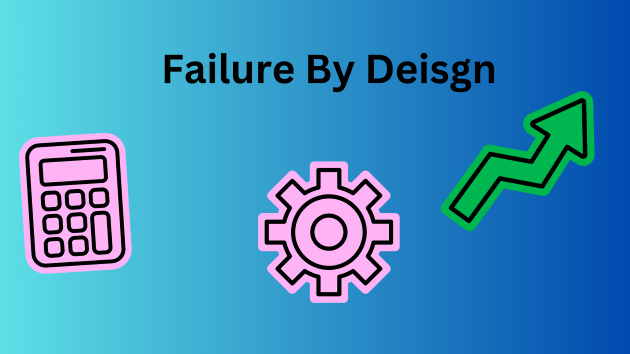Introduction
Failure by design is common in organizations today. Many entrepreneurs do not design their organizations with systems, processes, and structures to manage, mitigate, or learn from failures; rather, they are designed to fail. According to recent research by the Harvard Business Review, design failure is one major reason why a large percentage of SMEs hardly make it beyond their first two years. Several factors, including unprogressive and limiting processes, limit the growth of that organization. In this blog post, we will explore some of the key reasons SME brands fail fast by design, shedding light on internal factors that can profoundly impact their sustainability. From unhealthy internal organizational politics, setting unrealistic targets across the organization, importing operations, control, marketing, and sales practices from one industry into another, and taking advice from inexperienced business consultants, we will delve into the intricacies of organizational designs that have contributed to the failure of once-prominent SMEs brands.
Table of Contents

Signs that Your Brand is Designed to Fail
Branding failures are common, especially in SMEs, from failed celebrity beauty brands to mergers and franchising brand failures. Several SMEs start great but soon begin to adopt processes and practices incompatible with their cultures and specific peculiarities, joining the league of failed brands. A typical example is when an entrepreneur adopts so-called “industry best practices” recommendations from “experts” or business consultants without adapting or customizing those practices to reflect their unique brand personalities.
Some signs that your business or brand is unhealthy and possibly going south include frequent resignations by employees, mutual suspicion among staff members, a “not my responsibility or not my job attitude,” vociferous and fierce self-defence against sanctions in the event of a mistake or breach of policy, endemic blame culture, siloed teams, or a lone-wolf attitude, amongst others
Failure by Design: 5 Top Reasons Why SME Brands Fail Fast
1. Unhealthy Internal Organizational Politics
Success within SMEs often hinges on effective teamwork and collaboration—an environment where there is mutual trust and synergy between operations and control, marketing and sales, and admin and HR. However, the growth of internal organizational politics can become a silent but deadly disruptor. When employees are more focused on navigating political landscapes within the company than contributing to its success, it creates a toxic work environment. This can lead to a breakdown in communication, loss of morale, and ultimately, the failure of a once-thriving brand
2. Setting and Sticking to Unrealistic Targets
While setting ambitious goals is a cornerstone of business growth, sticking rigidly to unrealistic targets can have adverse effects. SMEs that fail to reassess and adapt their goals based on market changes or internal challenges may find themselves chasing unattainable objectives. This tunnel vision not only strains resources but can also lead to burnout among employees. The inability to adjust to market dynamics and recalibrate targets accordingly can contribute to the rapid decline of a successful SME.
3. Importing Industry Practices from Other Industries
Success in one industry does not guarantee success in another. SMEs that export practices from a thriving sector into a different, unrelated industry may find themselves facing unforeseen challenges. Each industry has its unique set of demands, customer expectations, and operational nuances. Blindly implementing strategies that worked in one sector into another can lead to misalignment with market needs and, ultimately, business failure.
4. Neglecting Innovation and Adaptability
One of the hallmarks of successful SMEs is their ability to innovate and adapt to changing market trends. However, complacency can occur after initial success, leading to a reluctance to embrace new technologies or business models. SMEs that neglect innovation risk becoming obsolete in a rapidly evolving marketplace. This lack of adaptability can be a significant factor in the swift decline of once-thriving brands.
5. Inadequate Financial Management
Financial mismanagement is a common factor in the downfall of successful SMEs. Poor budgeting, excessive spending, or failure to secure adequate funding can quickly erode profits. Without a solid financial foundation, SMEs may find themselves unable to weather economic downturns or invest in necessary areas like marketing, research, and development.
Conclusion
While achieving success as an SME is commendable, maintaining that success requires vigilance and adaptability. Unhealthy internal politics, the pursuit of unrealistic performance targets, industry practice exportation, neglecting innovation, and financial mismanagement are just a few of the pitfalls that can contribute to the fast failure of once-thriving brands. By addressing these challenges head-on and fostering a culture of adaptability and collaboration, SMEs can increase their chances of long-term success in today’s dynamic business environment.



